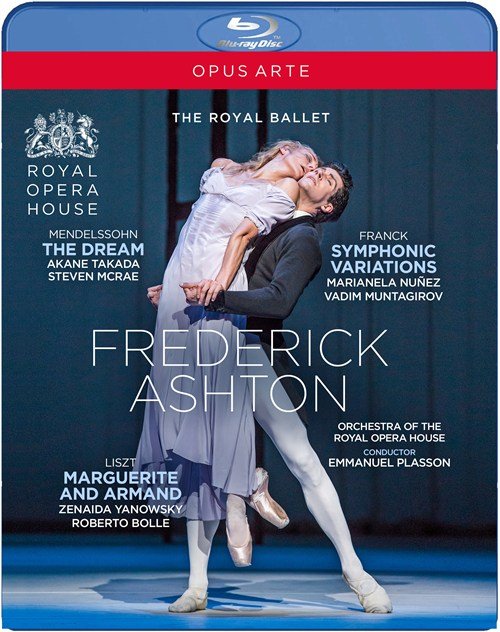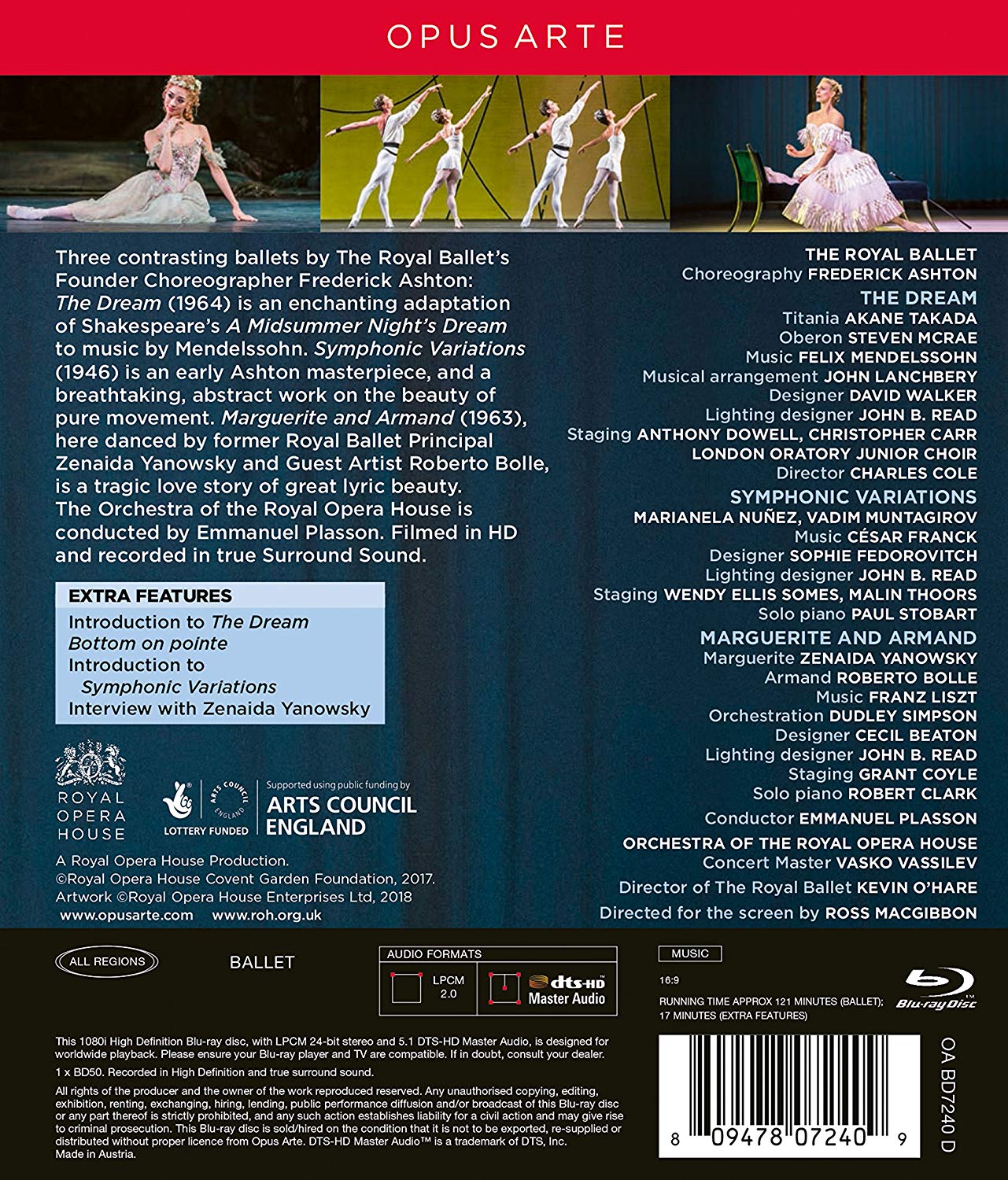

Triple bill of shorter ballets choreographed by Frederick Ashton — each work is quite different and unrelated to the others. All were recorded on the same day in June 2017 at a revival in honor of Ashton. Because the works are so different, we grade each separately:
Symphonic Variations. Music by César Franck. Features Marianela Nuñez, Vadim Muntagirov, Yasmine Haghdi, James Hay, Yuhui Choe, and Tristan Dyer. Solo piano by Paul Stobart. Designs by Sophie Fedorovitch; lighting by John B. Read, staging by Wendy Ellis Somes and Malin Thoors.
Marguerite and Armand. Music by Franz Liszt. Stars Zenaida Yanowsky (Marguerite), guest Roberto Bolle (Armand), Christopher Saunders (Armand’s father), Gary Avis (Duke), Mica Bradbury (Maid) and the following as admirers of Margarite: Matthew Ball, Reece Clarke, David Donnelly, Nicol Edmonds, Kevin Emerton, Tomas Mock, Fernando Montaño, and Erico Montes. Solo piano by Robert Clark. Orchestration by Dudley Simpson; designs by Cecil Beaton; lighting by John B. Read; staging by Grant Coyle.
The Dream. Music by Felix Mendelssohn. Stars Akane Takada (Titania), Steven McRae (Oberon), Ambrose Bartlett (Indian Boy), Valentino Zucchetti (Puck), Bennet Gartside (Bottom), Itziar Mendizabal (Helena), Tomas Mock (Demetrius), Claire Calvert (Hermia), Matthew Ball (Lisander), Gemma Pitchley-Gale (Peaseblossom), Emma Maguire (Cobweb), Elisabeth Harrod (Moth), and Romany Pajdak (Mustardseed). Choral singing by London Oratory Junior Choir directed by Charles Cole.
Emmanuel Plasson conducts the Orchestra of the Royal Opera House (Concert Master Vasko Vassilev). Directed for TV by Ross MacGibbon. Released 2018, disc has 4.1 dts-HD Master Audio sound. Grades: A for Symphonic Variations; A- for Marguerite and Armand; C+ for Dream.
Symphonic Variations
Symphonic Variations bears a similar relationship to English ballet that the Magna Carta bears to England. English ballet was revived just after WW II when the current Royal Ballet was established at the Royal Opera. Symphonic Variations was Ashton’s first work written for the Royal Ballet: it is abstract, classical, simple, eloquent, cheap to stage, and uses only 6 dancers who all stay on stage from start to finish. In Apollo’s Angels (2010, page 425) Jennifer Homans calls Symphonic Variations “practically a social democratic ballet” because it presents “a community of individuals bound together by discipline and a common pursuit.”
The individual steps are slow, stately, and appear to be relatively easy. But since the dancers get no breaks, the piece is in fact extremely demanding and can’t be performed by student or semi-pros. The first screenshot below is the final position at the end just before the curtain falls. It’s our best shot of the entire huge stage (the same stage where this premiered), which seems to magnify the importance of each move by the handful of tiny dancers who occupy it:
From left to right below the men are Tristan Dyer, Vadim Muntagirov, and James Hay:
The woman on the left below is Yasmine Naghdi, Marianela Nuñez is the center woman, and Yuhui Choe is on the right. Muntagirov gets the most attention. His main partner is, of course, Marianela Nunez, but he also gets to dance in ensemble with all three women at once:
But most of the formations involve Choe/Dyer, Nuñez/Muntagirov, and Haghdi/Hay as seen next below:
Symphonic Variations has been a favorite with dance critics down through the years. Now 70 years old, the dancing still looks fresh, impressive, and authoritative. We saw an old black-and-white photo from 1946. The costumes and design of the set seem to be exactly the same as on the first opening night (except possibly for the colors of the set). To us the costumes don’t seem outdated. But the set drawings from Sophie Fedorovitch seem in 2018 to be very analogue and old-fashion in today’s digital world. The designs make us think of nerds with slide-rules, but they might remind you of trips going on right now to visit asteroids. Another aspect of the set that gives us pause is the nasty-brown/slime-green color scheme—it’s hard to believe this was ever considered elegant and timeless. Still we find this a satisfying piece to watch despite it’s age and lack of updating.
SQ and PQ are fine. We did a wonk worksheet, and this has the best video content that we have seen from Ross MacGibbon! The video pace is a stately 14 seconds per clip and 87% of the clips show the whole bodies of the dancers! Print critics who saw this live in 2017 were mostly ecstatic to see this classic so well performed today. So this is a must-have disc for every ballet fanatic for two reasons: (1) it’s a faithful reproduction of what this work looked like when it was new and (2) it holds up well when compared to everything that has been done since then. As to a grade, we start with A+. We deduct to A for the unfortunate color scheme of the set.
Marguerite and Armand
This is, of course, a super-concentration of Verdi’s La Traviata opera. Marguerite and Armand was written in 1963 for Margot Fonteyn and Rudolf Nureyev as a retirement gift from Ashton to Fonteyn. Since then, every retiring prima ballerina dreams of going out the same way. In fact, we already have a Marguerite and Armand from the Royal Opera with Tamara Rojo dancing Marguerite as her last performance at the Royal Ballet. Well, when Rojo did this she was not retiring from dancing but moving to the English National Ballet where she is now both a star and the artistic director. So Rojo appears in her Marguerite and Armand as healthy-looking and beautiful as any ballerina ever was, and casting her as the poor dying Marguerite was a stretch. But there was no problem like this for Zenaida Yanowsky, who managed to stay on at the Royal Ballet past the bitter end.
Next below we see Zenaida as Marguerite hallucinating about her young lover Armand danced by Robert Bolle. The big projection of the lovers on the back wall was probably considered pretty cool in 1964 but looks a bit tacky today:
Next we have two close-ups of Marguerite and Armand falling in love at first sight:
Followed by shots of the lovers in the country:
Armand rashly breaks with Marguerite. In past productions of this, we understand the men wore white wigs. This was appropriate for the era in which this drama is set, but would still look pretty ridiculous today:
And finally, the death scene. We think this performance is about as effective as anyone could make it:
From the curtain calls:
If you want to see La Traviata in 29 minutes, this is the version to buy. We did a Wonk Worksheet. No surprise: because this is a narrative ballet, the conventional wisdom would be to speed up the pace while adding near shots and close-ups for a more movie-like experience. In fact the pace for this is a too-fast 8.5 seconds per clip, and only 58% of the clips show the whole bodies of the dancers. We concede this may be wise to help squeeze out some more sales of the video in the low-definition DVD market. But as champions of HD Blu-ray recordings, it’s our obligation to never shirk from the diagnosis of DVDitis when the patient has that disease. We reduce the A+ grade to B- for DVDitis. But because of the excellence of the dancing and acting in this performance, we bump the grade up to B+.
The Dream
Here Ashton attempts to compress Shakespeare’s five-act A Midsummer Night’s Dream into 55 minutes. This is the most famous comedy in all literature with an intricate and multi-faceted plot, and Mendelssohn’s music for this is on the same level as Tchaikovsky at his best. We think Ashton’s version is too short for viewers to understand well unless they know the play. We happen to have a wonderful HDVD of the Balanchine version of A Midsummer Night's Dream that is, we think, easier to enjoy than Ashton’s take. (We also have a complete outline of Shakespeare’s play to help anyone who needs a refresher course.) Still, Ashton’s The Dream is admired for it’s choreography.
Print critics in 2017 were almost universally ecstatic after seeing the Royal Ballet stars live in this. But Luke Jennings, writing for theguardian.com (June 11, 2017), raised a valid point complaining that The Dream (and the other works discussed above) looked dated to him:
“For all the choreography’s enduring sparkle, however, there’s a Miss Havisham look about the Royal Ballet’s Ashton repertoire. The clocks have been stopped, and time stands still [and the ] designs look dreadfully dated.
That this is a serious issue was recently confirmed by Tamara Rojo, director of English National Ballet. Rojo loves Ashton’s work, which she performed extensively as a dancer, but has said that she is unwilling to stage his ballets if she is not permitted to update the costumes to make them more appealing to young audiences. That she has not scheduled any Ashton works tells its own story.
Ballet is nothing if not a living art form, and Britain has no shortage of brilliant artists and designers who could revive dowdy productions. Left as they are, Ashton’s ballets will fade into a heritage twilight, like other “untouchable” artworks before them. And that would be a tragedy.”
Luke saw this from a seat in the audience. With the help of HD cameras and TVs, we in our home theaters can see the dowdiness much more clearly.
In our next two screenshots below, we see the forest fairies in The Dream dressed in typical older Royal Ballet pastel designs. These dresses look very much like the old designs used earlier by the Royal Ballet in it’s classic Sleeping Beauty:
Now compare the pastels above the newer and richer color scheme used in the Royal Ballet in its 2018 version of The Sleeping Beauty:
Now back to the old costumes in subject title. Akane Takada got a chance to star as an emergency replacement. Look at the rags she had to dance in!
Steven McRae is now one of the very top technical dancers in the world and gets many starring roles in London. He also gets a costume that appears to be older than he is! And this make-up needs to be reconsidered if HD cameras are going to be around!
Even the props look ridiculous:
And here’s what Valentino Zucchetti gets to wear as Puck:
The “human” costume are not too bad, but would these be colors pass muster today as worn by Matthew Ball and Claire Calvert?
Well, we didn’t want to invest time in a worksheet for this: we’ll just say the pace is faster than we would like. We have no idea whether the Royal Ballet is constrained from updating the Ashton designs by factors outside their control. But we suspect that Ashton works, like those of Balanchine in the United States, have been turned into exhibits in an intellectual property museum where, instead of living on, they are likely to fade away and be forgotten. For its brevity, excessive pace, and shabby costumes, we give this Dream a C+.
OR
























